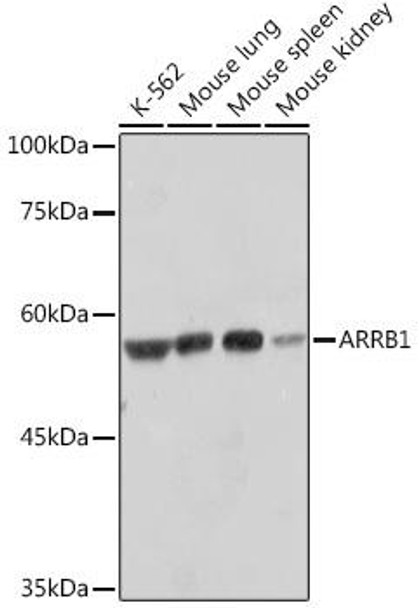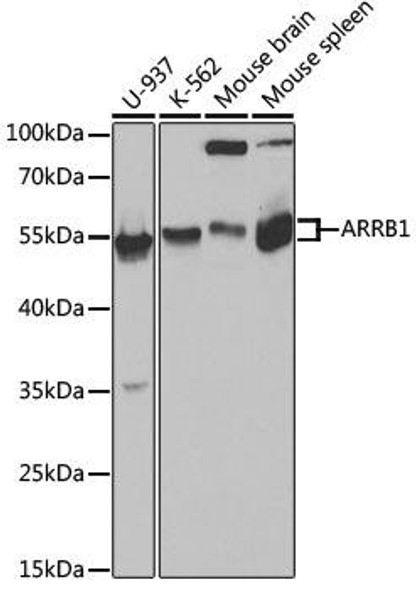Cell Biology Antibodies 2
Anti-ARRB1 Antibody (CAB10742)
- SKU:
- CAB10742
- Product Type:
- Antibody
- Reactivity:
- Human
- Reactivity:
- Mouse
- Host Species:
- Rabbit
- Isotype:
- IgG
- Antibody Type:
- Monoclonal Antibody
- Research Area:
- Cell Biology
Description
| Antibody Name: | Anti-ARRB1 Antibody |
| Antibody SKU: | CAB10742 |
| Antibody Size: | 20uL, 50uL, 100uL |
| Application: | WB |
| Reactivity: | Human, Mouse |
| Host Species: | Rabbit |
| Immunogen: | Recombinant protein of human ARRB1 |
| Application: | WB |
| Recommended Dilution: | WB 1:500 - 1:2000 |
| Reactivity: | Human, Mouse |
| Positive Samples: | K-562, Mouse lung, Mouse spleen, Mouse kidney |
| Immunogen: | Recombinant protein of human ARRB1 |
| Purification Method: | Affinity purification |
| Storage Buffer: | Store at -20'C. Avoid freeze / thaw cycles. Buffer: PBS with 0.02% sodium azide, 0.05% BSA, 50% glycerol, pH7.3. |
| Isotype: | IgG |
| Sequence: | Email for sequence |
| Gene ID: | 408 |
| Uniprot: | P49407 |
| Cellular Location: | Cell membrane, Cell projection, Cytoplasm, Cytoplasmic vesicle, Membrane, Nucleus, clathrin-coated pit, pseudopodium |
| Calculated MW: | 46kDa/47kDa |
| Observed MW: | 51KDa |
| Synonyms: | ARRB1, ARB1, ARR1 |
| Background: | Members of arrestin/beta-arrestin protein family are thought to participate in agonist-mediated desensitization of G-protein-coupled receptors and cause specific dampening of cellular responses to stimuli such as hormones, neurotransmitters, or sensory signals. Arrestin beta 1 is a cytosolic protein and acts as a cofactor in the beta-adrenergic receptor kinase (BARK) mediated desensitization of beta-adrenergic receptors. Besides the central nervous system, it is expressed at high levels in peripheral blood leukocytes, and thus the BARK/beta-arrestin system is believed to play a major role in regulating receptor-mediated immune functions. Alternatively spliced transcripts encoding different isoforms of arrestin beta 1 have been described. |
| UniProt Protein Function: | ARRB1: regulates G-protein coupled receptors (GPCR) signaling by mediating both receptor desensitization and resensitization processes. Binds to GRK-phosphorylated receptor and sterically preclude its coupling to the cognate G- protein; the binding appears to require receptor determinants exposed only in the active receptor conformation. Targets many receptors for internalization by acting as endocytic adapters (CLASPs, clathrin-associated sorting proteins). Internalized arrestin-receptor complexes traffic to intracellular endosomes, where they remain uncoupled from G-proteins. Two different modes of arrestin-mediated internalization occur. Beta-arrestins function as multivalent adapter proteins that can switch the GPCR from a G-protein signaling mode that transmits short-lived signals from the plasma membrane via small molecule second messengers and ion channels to a beta-arrestin signaling mode that transmits a distinct set of signals that are initiated as the receptor internalizes and transits the intracellular compartment. Also involved in regulation of receptors other than GPCRs. Involved in Toll-like receptor and IL-1 receptor signaling through the interaction with TRAF6 which prevents TRAF6 autoubiquitination and oligomerization required for activation of NF-kappa-B and JUN. Binds phosphoinositides. Binds inositolhexakisphosphate (InsP6). Involved in IL8-mediated granule release in neutrophils. Interacts with phosphorylated ADRB2 and CHRM2. Interacts with SRC (via the SH3 domain and the protein kinase domain); the interaction is independent of the phosphorylation state of SRC C-terminus. Interacts with RAF1, CHUK, IKBKB and Nik. Interacts with DVL1 and DVL2; the interaction is enhanced by DVL phosphorylation. Interacts with IGF1R. Belongs to the arrestin family. 2 isoforms of the human protein are produced by alternative splicing. |
| UniProt Protein Details: | Protein type:Adaptor/scaffold Chromosomal Location of Human Ortholog: 11q13 Cellular Component: basolateral plasma membrane; chromatin; coated pit; cytoplasm; cytoplasmic vesicle; cytoplasmic vesicle membrane; cytosol; dendritic spine; Golgi membrane; heterotrimeric G-protein complex; lysosomal membrane; nucleoplasm; nucleus; plasma membrane; postsynaptic density; postsynaptic membrane; pseudopodium Molecular Function:alpha-1A adrenergic receptor binding; alpha-1B adrenergic receptor binding; angiotensin receptor binding; caspase inhibitor activity; enzyme inhibitor activity; estrogen receptor binding; follicle stimulating hormone receptor binding; GTPase activator activity; histone acetyltransferase activity; insulin-like growth factor receptor binding; mitogen-activated protein kinase kinase binding; protein binding; protein phosphorylated amino acid binding; transcription factor binding; ubiquitin protein ligase binding; V2 vasopressin receptor binding Biological Process: activation of MAPK activity; blood coagulation; follicle-stimulating hormone signaling pathway; G-protein coupled receptor internalization; inhibition of NF-kappaB transcription factor; negative regulation of caspase activity; negative regulation of interleukin-6 production; negative regulation of interleukin-8 production; negative regulation of protein ubiquitination; Notch signaling pathway; phototransduction; platelet activation; positive regulation of caspase activity; positive regulation of GTPase activity; positive regulation of histone acetylation; positive regulation of peptidyl-serine phosphorylation; positive regulation of protein amino acid phosphorylation; positive regulation of protein binding; positive regulation of protein ubiquitination; positive regulation of receptor internalization; positive regulation of Rho protein signal transduction; positive regulation of transcription from RNA polymerase II promoter; post-Golgi vesicle-mediated transport; proteasomal ubiquitin-dependent protein catabolic process; protein transport; protein ubiquitination; stress fiber formation; transcription from RNA polymerase II promoter |
| NCBI Summary: | Members of arrestin/beta-arrestin protein family are thought to participate in agonist-mediated desensitization of G-protein-coupled receptors and cause specific dampening of cellular responses to stimuli such as hormones, neurotransmitters, or sensory signals. Arrestin beta 1 is a cytosolic protein and acts as a cofactor in the beta-adrenergic receptor kinase (BARK) mediated desensitization of beta-adrenergic receptors. Besides the central nervous system, it is expressed at high levels in peripheral blood leukocytes, and thus the BARK/beta-arrestin system is believed to play a major role in regulating receptor-mediated immune functions. Alternatively spliced transcripts encoding different isoforms of arrestin beta 1 have been described. [provided by RefSeq, Jan 2011] |
| UniProt Code: | P49407 |
| NCBI GenInfo Identifier: | 20141238 |
| NCBI Gene ID: | 408 |
| NCBI Accession: | P49407.2 |
| UniProt Secondary Accession: | P49407,O75625, O75630, Q2PP20, Q9BTK8, B6V9G8, |
| UniProt Related Accession: | P49407 |
| Molecular Weight: | 46,309 Da |
| NCBI Full Name: | Beta-arrestin-1 |
| NCBI Synonym Full Names: | arrestin beta 1 |
| NCBI Official Symbol: | ARRB1 |
| NCBI Official Synonym Symbols: | ARB1; ARR1 |
| NCBI Protein Information: | beta-arrestin-1 |
| UniProt Protein Name: | Beta-arrestin-1 |
| UniProt Synonym Protein Names: | Arrestin beta-1 |
| Protein Family: | Beta-arrestin |
| UniProt Gene Name: | ARRB1 |
| UniProt Entry Name: | ARRB1_HUMAN |







